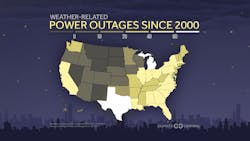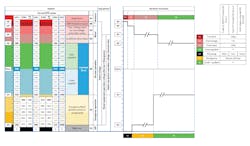Prediction for readers: DC Microgrids combining technologies such as solar, battery energy storage, EVs and fuel cells on a common DC bus will go from one off, newsworthy projects to more everyday products. The increased pace of deployment of such systems will follow the analogy of water swirling down the drain above. Before long, the pace will become dizzying. The only difference is that the funnel of demand for DC Microgrids given the world’s current direction of travel in electrification is virtually limitless.
If you are not sure what a DC Microgrid even is (no shame in that!) click here to learn more before proceeding.
Driving Factors of DC Microgrid Deployment
There are several factors driving the increased momentum in DC Microgrid adoption and deployment. First and foremost are the market forces creating demand for the clean, resilient and dispatchable power renewables-based DC Microgrids provide. Market demand serves as the gravitational pull in our drain analogy (see Figure 2 below).
The enabling factors speeding the rotation of the vortex of DC Microgrid adoption today including a favorable political environment for renewables adoption, the continued development of standards around such deployments and quickly maturing software and hardware technologies for use in such projects. This confluence of these factors is helping to blossom the fruits of the labors of a number of individuals and organizations who have been working tirelessly at developing the DC Microgrid space for years.
The balance of this article explains these various factors to help you understand the coming acceleration in the rate of deployment of DC Microgrids.
Market Needs
First and foremost, the growth of renewables-based DC Microgrids is being driven by energy consumers’ need and desire to have clean electric power that can be delivered continuously regardless of the state of the broader utility grid or the weather. Even in advanced economies like the United States, our already overtaxed power distribution grid is under greater strain with the electrification of everything, a situation only made more difficult by the challenges presented by climate change. Today, the cleanest, most readily available and cost-effective source of electric generation is solar, a DC source. Solar is of course an intermittent generator, which when deployed on its own, can actually add to grid instability. One obvious solution to this challenge is pairing solar with battery energy storage (batteries are both a DC source and a DC load) to turn solar from an intermittent generator into a dispatchable and predictable one. At the same time, the crowded grid has less capacity for new, large points of distributed AC grid interconnection. Hence, pairing solar and storage, along with other localized DC sources like fuel cells and DC loads like EVs behind a single point of grid interconnection, i.e. a single grid forming inverter (otherwise known as a DC Microgrid) are our best bet for balancing all the conditions above.
Standards Development
Since you are reading this article on Microgrid Knowledge, you have probably heard the saying “If you’ve seen one Microgrid, you’ve seen one Microgrid.” To be sure, today, DC Microgrid projects are decidedly bespoke (fancy word for custom) projects. Given they are generally smaller in size, as a function of their distributed nature, that means soft costs like engineering and design can be a disproportionate, all be it necessary, amount of their deployment cost. One way to reduce these soft costs is through standardization. In this regard, groups like CurrentOS and the Emerge Alliance have come together to write standards for DC Microgrid development. Generally speaking, the world of DC distribution has a century’s worth of catching up to do with AC distribution. However, this work is evolving rapidly, hence its contribution to the increased momentum in our water analogy above.
Legislative Environment
The Inflation Reduction Act (IRA), passed in August of 2022 will funnel billions of dollars into programs supporting clean energy deployment and climate action. According to the Biden Administration, the IRA “mark[s] the most significant action Congress has taken on clean energy and climate change in the nation’s history.” Bear in mind, this legislation is not even a year old. Reading through the provisions of the IRA telegraphs the incentives for acceleration of the creation of DC Microgrids of all shapes and sizes, including explicitly making provision for investment tax credits for Microgrid projects less than 20 MW with grid interconnections of less than 5 MW. DC Microgrids represent a great opportunity to do just this, as they allow for significant “DC overbuild” of generation relative to the size of the grid interconnection. With a DC Microgrid, excess DC solar generation can be diverted directly into battery energy storage for use when that excess generation is not needed and then discharged from the battery when the solar is not available, including at night and on cloudy days.
Technology Evolution
Neither the legislative environment nor the development of standards would be helpful if the technology to support DC Microgrids was not evolving. One major area of evolution here is power conversion. Historically, power conversion has been the domain of inverters (DC to AC converters) or rectifiers (AC to DC converters). With the rapid evolution of the DC Microgrid, the DC:DC converter has stepped into the fore of power conversion to serve as the bridge between DC sources and loads interacting in a native DC environment. DC converters can come in many sizes and a topologies, as one size most assuredly does not fit all. Here at Alencon, we have evolved our product development efforts to assure we are building a comprehensive suite of DC:DC solutions to offer DC Microgrid developers complete solutions to all the nuanced challenges they face in deploying these projects.
Of course, DC:DC converter development is just one piece of the puzzle. Additionally, the other cornerstones of DC systems of course continue to evolve including solar panels and energy storage means. The technological evolution is not reserved to the solid state, but also to a wide range of software solutions from Microgrid controllers to DC Microgrid design and simulations solutions.
The Tireless Work of DC Evangelists
It’s been said that revolution seldom benefits the revolutionary. Fortunately, with the coming increased pace in the deployment of DC Microgrids that hopefully will not be the case in this domain. In fact, in the coming years, DC Microgrids will likely prove to be the greatest overnight success story that took far longer to achieve thanks to the tireless work of a number of visionary people and organizations that came along the way. I am pleased to call a number of these folks my colleagues, partners, customers and friends and would like to take a moment some of them including Luis Zubieta and Gary Oppedahl of Emera Technologies, Harry Stokman of DC Systems and Current OS, Paul Savage and Brian Patterson of the Emerge Alliance, Michael Muhlbaier, OIeg Fishman and the team at Alencon Systems, Troy Barrie from Ariya Finergy, Dusan Brhlik of Direct Energy Partners, David Lawrence of Duke Energy, Huang Iu and his team at Eneon ES, Aleksey Toporkov and Peter Lehn of ARDA Power. This is hardly a comprehensive list of people and organizations leading this DC driven evolution, but likely a list of names you may never have heard of but will have to thank as the DC Microgrid their resultant benefits become more commonplace.













